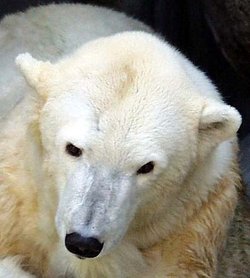Bear
|
|
| Bear | ||||||||||
|---|---|---|---|---|---|---|---|---|---|---|
 American Black Bear | ||||||||||
| Scientific classification | ||||||||||
| ||||||||||
| Genera | ||||||||||
|
Ailuropoda |
A bear is a large mammal of the order Carnivora, family Ursidae. The adjective, ursine, is used to describe things of bearlike nature.
| Contents |
Physical attributes
Common characteristics of bears include a short tail, excellent senses of smell and hearing, five un-retractable claws, and long, dense, shaggy fur.
Bears have a large body with powerful limbs. They are capable of standing up on their hind legs. They have broad paws, long snouts, and round ears. Their teeth are used for defense and tools and depend on the diet of the bear. Their claws are used for ripping, digging, and catching.
Habitats
Bears live in a variety of habitats from the tropics to the Arctic and from forests to snowfields. They are mainly omnivorous, although some have a more specialised diet, such as polar bears. They eat lichens, roots, nuts, and berries. They can also go to a river or other body of water to capture fish. Bears will commonly travel far for food. Hunting times are usually in the dusk or the dawn except when humans are nearby.Some of the large species, such as the polar bear and the grizzly bear, are dangerous to humans, especially in areas where they have become used to people. For the most part, bears are shy and are easily frightened of humans. They will, however, defend their cubs ferociously.
Reproductive behaviour
The bear's courtship period is very brief. Bears reproduce seasonally, usually after hibernation. Cubs come out toothless, blind, and bald. The cubs, usually born in litters of 1–3, will stay with the mother for six months. They will be fed by milk at first and will start hunting with the mother in three months. Then, they are weaned. However, they will still remain nearby for three years. The cubs are more sexually mature at seven years. Normally, bears are very solitary and will not remain close together for long periods of time.
Other
Many bears of northern regions are assumed to hibernate in the winter. They actually don't hibernate. Their body temperature sinks a moderate amount and they can be easily awakened.
Laws have been passed in many areas of the world to protect bears from hunters or habitat destruction. Bears in captivity used to be trained to dance, box, or unicycle, but it is now controversial to use animals in this way.Bears have an average life expectancy of 25–40 years.
Polar bears are the largest type of bear, indeed one of the largest carnivores on terra firma. Sun bears are the smallest, only a bit smaller than the average woman.
Classification
- Family Ursidae
- Subfamily Ailuropodinae
- Giant Panda, Ailuropoda melanoleuca
- Subfamily Tremarctinae
- Andean Bear, Tremarctos ornatus
- Florida Cave Bear, Tremarctos floridanus (extinct)
- Giant Short-Faced Bear, Arctodus simus (extinct)
- Short-Faced Bear, Arctodus pristinus (extinct)
- Subfamily Ursinae
- Brown Bear, Ursus arctos
- American Black Bear, Ursus americanus
- Polar Bear, Ursus maritimus
- Asiatic Black Bear, Ursus thibetanus
- Auvergne Bear, Ursus minimus (extinct)
- Etruscan Bear, Ursus etruscus (extinct)
- European Cave Bear, Ursus spelaeus (extinct)
- Atlas Bear, Ursus crowtheri (extinct)
- Sloth Bear, Melursus ursinus
- Sun Bear, Helarctos malayanus
- Subfamily Ailuropodinae
The genera Melursus and Helarctos are sometimes included in the genus Ursus. The Asiatic black bear and the polar bear used to be placed in their own genera, Selenarctos and Thalarctos.
Evolutionary relationships
Bears are members of the Order Carnivora, Sub-Order Caniformia, and Family Ursidae. Other members of the Caniformia include wolves and other dog-like mammals (Family Canidae), weasels, skunks, and badgers (Family Mustelidae), raccoons (Family Procyonidae), and walruses (Family Odobenidae), seals (Family Phocidae), and sea lions (Family Otariidae). Although bears are often described as having evolved from a dog-like ancestor, their closest living relatives are the pinnipeds (walruses, seals, and sea lions).
The origins of the bears can be traced back to the raccoon-sized, dog-like Cephalogale from the middle Oligocene and early Miocene (approximately 20-30 million years ago) of Europe. Cephalogale gave rise to a lineage of early bears, the genus Ursavus. This genus radiated in Asia and ultimately gave rise to the first true bears (genus Ursus) in Europe, 5 million years ago. Extinct bear genera includes Arctodus, Agriarctos, Agriotherium, Plionarctos and Indarctos.
Although there has previously been much discussion as to whether the Giant Panda belongs to the bear family or the raccoon family, recent DNA analyses have shown that the Giant Panda is a member of the Family Ursidae and as such is more closely related to other bears. The status of the Red Panda remains uncertain, but many experts, including Wilson and Reeder, classify it as a member of the bear family. Others place it with the racoons in Procyonidae or in its own family, the Ailuridae. The many similarities between the two pandas are thought to represent convergent evolution for feeding primarily on bamboo.
Pictures of Bears
- Pictures of Bears (https://classroomclipart.com/clipart/Animals/Bears.htm)
- Bear Clipart (https://classroomclipart.com/clipart/Clipart/Animals/Bear_Clipart.htm)
Clipart and Animal Pictures
- Clipart (https://classroomclipart.com/image/category/clipart.htm)
- Animal Clipart (https://classroomclipart.com/image/category/animal-clipart.htm)
- Animal Animated Clipart (https://classroomclipart.com/clipart/Animations/Animals.htm)
- Pictures of Animals (https://classroomclipart.com/image/category/animal-photos.htm)
- Amphibian Clip Art, Pictures and Photogaphs (https://classroomclipart.com/image/category/amphibian-clipart.htm)
- Farm Animal Clip Art, Pictures and Photographs (https://classroomclipart.com/image/category/farm-animal-clipart.htm)
- Mammal Clip Art, Pictures and Photographs (https://classroomclipart.com/image/category/mammal-clipart.htm)
- Marine Animal Clip Art, Pictures and Photographs (https://classroomclipart.com/image/category/marine-life-clipart.htm)
- Reptile Clip Art, Pictures and Photographs (https://classroomclipart.com/image/category/reptile-clipart.htm)
- Spider Clip Art, Pictures and Photographs (https://classroomclipart.com/image/category/spider-clipart.htm)






